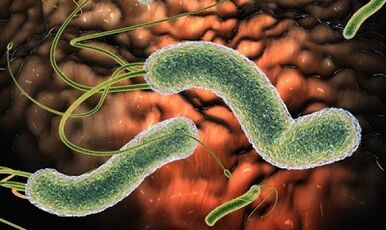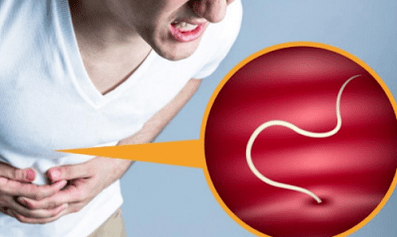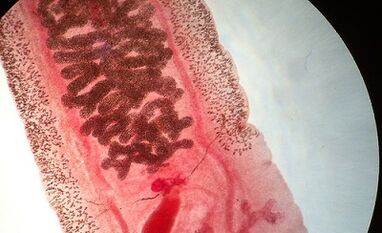
Among the patients, a serious misconception is that helminths only live in the intestine.However, it is undeniable that the parasites in human blood are as spacious as other types of helminths.The timely identification and treatment of such pathological states requires special attention, because when it falls into the blood, a small socket can completely hit any organ.
Symptoms and pains that cause blood worms in humans may vary in both manifestations and severity of them.It is important to start timely treatment and prevent the spread of parasites on the human body to prevent complicated consequences in a timely manner.Initially, need to find out how worms appear in the blood.
Parasites placed blood
Nothing is much complicated by the accurate diagnostic production as a major spread of symptoms manifested in patients with parasites in the blood.Different types of helminths cause different signs.In the case of worm infection with blood or blood vessels, patients need to undergo a complete medical examination will help determine the type of parasite and determine the full treatment of the pathology.
There are several parasites that can live in human blood:
- Babesia;
- Malaria Plasmodium;
- Tripanosoma;
- Ankylostoma;
- Trichinella;
- Toxoplasma;
- Toksokara.
Most helminths enter the human body after biting insects.Such parasites of the circulatory channel are the most dangerous for children.They affect the proper development of organs, the development of all creatures and the status of the immune system.Many people can live with parasites for many years and do not even doubt they are infected.
The general symptoms of parasitic blood poisoning
Each type of parasite in human blood has symptoms typical of this disease.
However, there are some typical signs of any type of Helminthosis:
- Weaknesses;
- dizziness, headache;
- nausea, vomiting;
- Can increase the total body temperature;
- pain in limbs and all body;
- Attack loss is possible.
All of these symptoms are the main manifestations of the increased content of toxic substances in the body.For the first time, it is necessary to contact a medical organization where doctors will conduct all the necessary diagnostic tests and processes, which will most accurately determine the cause of that condition.
Babesiosis: Symptoms, diagnosis and treatment
Babesia is a small parasite that invades the human body after biting a cartridge.These simplest organisms quickly enter the inner red blood cell membrane and start their difficult life cycle.The disease is widely used in warm areas where the Ixodes family live.
In most cases, the disease proceeds without clear symptoms in both adults and children.
However, when the disease appears and is further developed, the characteristics are recorded:
- Hemolytic anemia;
- fever to 39-40 degrees;
- chills;
- Increase sweat.
Similar symptoms appear for no more than 4 weeks after biting of ticks.After the incubation period, the opportunity to identify the disease is much higher.
The disease can only be diagnosed in the conditions of specialized laboratories.For this reason, there is not too much data on the spread of the disease and its symptoms.
However, doctors should take some measures to identify non -aliens causing disease in the patient's body:
- General blood test;
- Serum test for antibodies for women;
- Polymerase chain reaction;
- Check by microscopy of blood spread (dyed by hymn).
Treatment is performed mainly with antipipotozoal drugs.Typically, the process of taking such money lasts no more than 10 days, but can continue in patients with a recurrent disease form.Treatment for patients with no symptoms is performed when the pathogens of Babusiosis are detected in the blood during a recurrence process, performed a few months after initial detection, when the disease participates in recurrence.
Tripanosomosis: Symptoms, diagnosis, treatment

Tripanosomosis, or drowsiness, is popular in tropical and subtropical countries and is rarely found at temperate latitude.The pathogens of the disease are a tripanosome.This is a small parasite.Looking at the image of the parasite made of electron microscopes, you can distinguish flagella and membrane along the entire length of the body.
The disease and its symptoms develop in two full stages.In the first stage, parasites invaded human red blood cells and began to reproduce active.
This stage can be recognized by the following signs:
- The fever is up to 7 days;
- headache, weak;
- joint pain and limbs;
- Serious itching;
- The appearance of Red Chacks in the position of inflamed lymph nodes.
In the second phase of the disease, Tripanosome penetrates into the central nervous system through the hematoencephalic fence.This stage is characterized by sleep and serious waking cycle - the main symptom of the disease.
In addition, in patients in the second stage of drowsiness may appear:
- Fuzzy consciousness;
- muscular trembling, weak;
- limbs are paralyzed;
- indifference;
- uncomfortable;
- Invasion related to others.
It is necessary to start treatment as soon as possible, otherwise it is not the most favorable result.Progress, the disease leads to the appearance of organs of some body systems at the same time, its consequences are the death of the patient.
Diagnosis of sleeping based on patients' symptoms and microbiological studies for the presence of tripanos in the blood, lymph and purulent liquids taken from Shancra.With positive samples, treatment is urgently prescribed.
A good prognosis can be done when the disease can be detected at the hemolytic stage.At this time, the quite toxic drugs are prescribed, but in general, the treatment is well tolerated by the patient's body.
However, when the disease only realized in the second stage, the prognosis is not always comforted.In order to treat such a pathological condition, it is necessary to use toxic and serious drugs that can penetrate through the protective barrier of the central nervous system.
Malaria fever: Symptoms and treatment

Passmodium malaria infection occurs through a mosquito bites.Through the salivary glands of children, parasites entering a person's blood, transferred by blood into the liver, where the first stages of metamorphosis pass, and then once again enter the bloodstream and affect red blood cells.
The incubation period of the disease lasts up to 25 days.After that, the first symptoms of malaria were manifested:
- body temperature increased sharply;
- Headache, weak;
- Hemolytic anemia;
- Queen of the skin;
- nausea, vomiting;
- Pain of joints, pain throughout the body;
- seizures;
- The appearance of products destroys red blood cells in urine.
Basically, this disease spreads in warm and hot areas, so its diagnosis is based on symptoms and history of the patient's life manifests itself over time.Traveling regularly to the equatorial countries can cause the development of the disease.In addition, standard blood tests and microbiological testing of body liquid are performed.
The prescribed therapy depends on the type of disease and its severity and is done mainly by using anti -malarial drugs.
Ankylostomosis: Symptoms, diagnosis and treatment
Parasites cause life in the genes of the intestine and eat the blood cells of the subject.The worms penetrate a person's skin and start migrating into the intestine.In the process of moving around the body, parasites with blood flow falls into the lungs, then walking along the bronchus in the trachea and upper respiratory tract, where they stimulate swallowing reflexes, and thus the intestine, on the walls are fixed.
In rare cases, worms of worms cannot accomplish their movement and under the skin of a person.In the photo, a similar process is like small, thin snakes under the patient's skin.

Eating blood and worms causes the development of iron deficiency anemia in infected people.The most dangerous when worms penetrate the children's body.The deficiency of iron, protein and other essential components for children's development can cause mental retardation, developmental delay and physical low.
The main symptoms of ankylostomosis:
- Iron deficiency anemia;
- fever;
- abdominal pain;
- nausea, vomiting;
- diarrhea, constipation;
- Losing serious body weight;
- Cough, infectious diseases of the upper respiratory tract during the movement of larval stages of parasites are possible.
Among the diagnostic measures, general blood tests, analysis and urine, an ultrasound test of the digestive system is distinguished.The identification of parasites becomes a good reason to start immediately and prevent pathological conditions related to the activity of the patient's respiratory, digestive and circulating systems.
Treatment is performed by one one -time drink of anti -cancer drugs.The therapy is supplemented with the use of vitamin and minerals complexes, which allows to reduce the consequences of hemoglobin deficiency.
Toxocarosis: Symptoms and treatment
The pathogens of this disease are round helminths, which a person may receive after prolonged contact with livestock without roundworm, when eating vegetables and unused fruits.The human body becomes an intermediate host of parasites.
Going into the intestines, the larvae hatch from eggs and began to drill into the intestinal wall, penetrating the blood.With blood flow, helminths move into any system of the human body.The result of migration of worms is serious weakening of the liver, heart, central nervous system and visual organs.

The main symptoms of the body's body infection:
- increase total body temperature;
- the appearance of severe abdominal pain;
- Weaknesses, dizziness;
- the appearance of allergens on the skin;
- cough at night;
- Convulsions, muscles and joint pain.
Diagnosis is quite difficult.It is necessary to conduct serious allergic and microbiological tests that need a specialized laboratory:
- Polymerase chain reaction;
- Immunotherapy;
- Hematology tests;
- Ultrasound examination of agencies;
- Magnetic resonance and calculation layer cutting.
Serious treatment therapy is only performed when the patient's severe damage is detected.Very often goes through independence, because the larvae cannot develop into an adult individual in the body of an intermediary host.
However, it is necessary to take into account the harm that migration worms can cause patients.Support therapy should be taken and implemented necessary measures to prevent the development of serious pathological processes in the liver, cardiovascular and other organs.
Conclusion
Any parasite is dangerous to the human body.If the questions arise, then what parasites live or use blood as a transportation system, how to determine exactly or not, how to treat them and what they need to use, it is best to contact a parasite and do not make independent decisions.Treatment and prevention of parasitic diseases is a decision that a doctor eligible for.





























